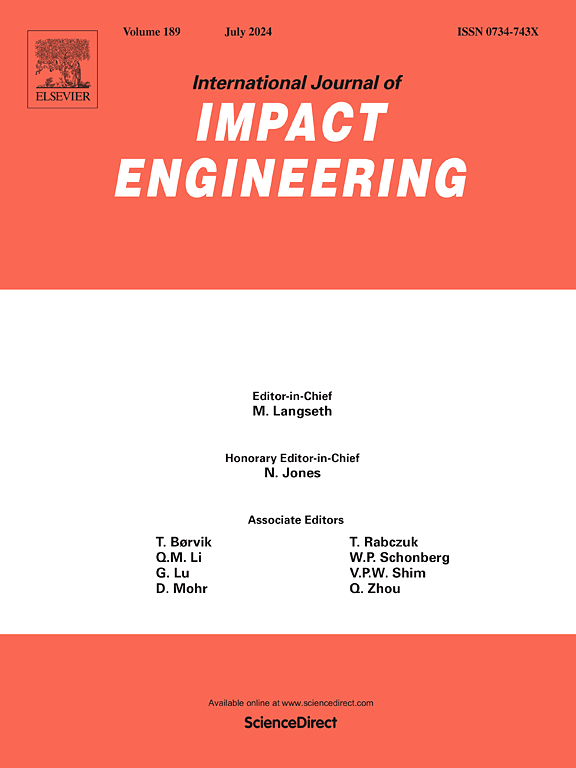Experimental and numerical investigation on scattering evaluation behavior of forward ejecta and debris clouds from aluminum and magnesium alloy plates
IF 5.1
2区 工程技术
Q1 ENGINEERING, MECHANICAL
International Journal of Impact Engineering
Pub Date : 2025-03-07
DOI:10.1016/j.ijimpeng.2025.105298
引用次数: 0
Abstract
This study evaluates the dispersion behavior of forward ejecta and debris clouds produced by hypervelocity impacts on aluminum alloy AA6061-T6 and magnesium alloy AZ31B-H24 plates through experiments and simulations. Whipple shields, used in space structures to protect against microdebris, have inspired the testing of aluminum-magnesium clad materials by our group to enhance impact resistance. To gather essential data on the protective performance of these materials, impact tests were conducted at 2, 6, and 7 km/s using AA2017-T4 sphere projectiles. Simulations applied the Johnson–Cook model, Mie–Grüneisen equation of state, and FEM-SPH methods to model large deformations. Results indicate that forward ejecta primarily consists of fragments from the target material, with its dispersion influenced by initial deformation patterns. The mass of forward ejecta increases with impact velocity, while high-energy absorption results in larger perforations and narrower, slower debris clouds. While AZ31B-H24 disperses debris more effectively, AA6061-T6 shows better post-impact protection by reducing projectile kinetic energy. Optical measurements of pressurized walls provided insights into the link between debris cloud dispersion and alloy protective performance.
铝镁合金板正向抛射物和碎片云散射评价行为的实验与数值研究
本研究通过实验和模拟,评估了超高速撞击在铝合金AA6061-T6和镁合金AZ31B-H24板材上产生的前向抛射物和碎片云的扩散行为。惠普尔防护罩用于太空结构以防止微碎片,启发了我们小组对铝镁复合材料进行测试,以增强抗冲击性。为了收集有关这些材料防护性能的重要数据,我们使用 AA2017-T4 球形弹丸以 2、6 和 7 千米/秒的速度进行了冲击试验。模拟采用了约翰逊-库克模型、米氏-格吕尼森状态方程和 FEM-SPH 方法来模拟大变形。结果表明,前向喷出物主要由目标材料的碎片组成,其分散程度受初始变形模式的影响。前向喷出物的质量随撞击速度的增加而增加,而高能吸收则导致穿孔增大,碎片云变窄,速度变慢。AZ31B-H24 能更有效地分散碎片,而 AA6061-T6 则能通过降低弹丸动能提供更好的撞击后保护。通过对加压壁进行光学测量,可以深入了解碎片云分散与合金防护性能之间的联系。
本文章由计算机程序翻译,如有差异,请以英文原文为准。
求助全文
约1分钟内获得全文
求助全文
来源期刊

International Journal of Impact Engineering
工程技术-工程:机械
CiteScore
8.70
自引率
13.70%
发文量
241
审稿时长
52 days
期刊介绍:
The International Journal of Impact Engineering, established in 1983 publishes original research findings related to the response of structures, components and materials subjected to impact, blast and high-rate loading. Areas relevant to the journal encompass the following general topics and those associated with them:
-Behaviour and failure of structures and materials under impact and blast loading
-Systems for protection and absorption of impact and blast loading
-Terminal ballistics
-Dynamic behaviour and failure of materials including plasticity and fracture
-Stress waves
-Structural crashworthiness
-High-rate mechanical and forming processes
-Impact, blast and high-rate loading/measurement techniques and their applications
 求助内容:
求助内容: 应助结果提醒方式:
应助结果提醒方式:


